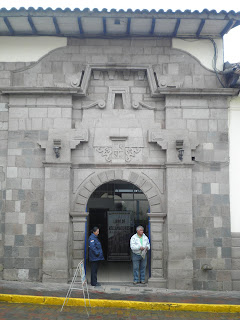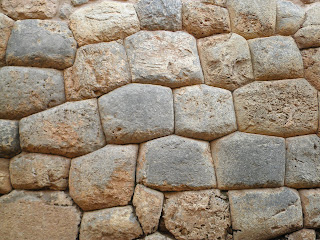The fantastic thing about tomorrows is the supply we have of them. Take a peek into the tomorrow stockroom and you'll glimpse infinity. Most of the time, of course, we don't look for tomorrow--we wait for it to come to us, which it does, every day, regular as clockwork. Tomorrow, with its infinite supply and low demand, is one of the cheapest things around, a fact I've found to be particularly well recognized in Latin America. Here tomorrows are dropped like pennies on the street and left there for eternity, not worth bending down to pick up and make into today.
For someone who yearned to grasp a particular tomorrow, Cusco was a bad place to do it. That tomorrow was the day I would receive my motorcycle registration card and be cleared to make a break for Chile. That tomorrow ended up being yesterday (
most of this post was written on the 23rd in Puno, in a hotel lobby during a noisy confrontation about a stolen bicycle, the red-handed thief locked inside with his accusers until the police arrived), but yesterday was tomorrow #20. Tomorrows #1-20 comprised an odyssey all their own, a journey within a journey, travels not through geography but rather through diverse states of mind and the wacky labyrinth of Peruvian bureaucracy.
Today (aka tomorrow #0): Having purchased the motorcycle, I went with the seller to a notary to formalize the sale and start the registration process. The notary was a short, brusque man in a double-breasted suit and hair that looked like a lid. He shook our hands and in about 15 seconds typed a two-page document that turned out to be a bill of sale. I was assured he would take care of all the details with the Public Registries office, and I could just kick back and relax. Come back in a week or so and everything would be ready, "without fail." Oh, and all measures would be taken to address the urgency of the matter. The professional reassurances matched the suit and hair.
Tomorrows #1-10: Rather than kick back and trust in "a week or so," I did a bit of independent investigating. A lady at the Public Registries office whose brusqueness rivaled the notary's told me that my card would take seven business days to be printed and sent to Cusco, including the day I submitted it. So, counting two weekends and one public holiday (December 8th: Day of the Immaculate Conception), I expected tomorrow #11 to be the big day. That was cutting it close, too. I'd made plans with my Czech friend Kristyna to hike the Colca Canyon starting on tomorrow #12. As the week of waiting drew on, though, I talked with several people who named different numbers of business days (ten was popular). These were Peruvians. Non-Peruvians who'd dealt with the country's workings all eschewed the language of business days in favor of a doom-and-gloom lexicon which included entries like "months" and "impossible." In light of my sleuthing I backed out of my hiking plan with Kristyna, which, without the registration in hand, would have involved a lot of going back and forth over long distances. Instead I geared up to distract myself for a few days with a solo hike closer to Cusco (see http://gabrielsouthamerica.blogspot.com/2011/12/ausangate-circumnavigation-par.html).
Tomorrow #11: The high from my amazing hike vaporized upon my arrival back in Cusco. I walked to the notary's office with a sinking feeling, dreading a bureaucratic delay, knowing it would react badly, like a fifth-grade sodium volcano, with my traveller's impatience to get on the road. As I feared, visiting the notary was a bad start to a bad day. The first thing he said, before he finished shaking my hand, was, "No, it hasn't arrived. Why don't you come back next Thursday?" NEXT THURSDAY!? That was nine days away! Seeing the panic begin to rise up my face, he hurriedly added, "Here, take a look through these papers. Maybe it has arrived." So I leafed through a disorderly stack of forms with registration cards paperclipped to them. Although the names were fascinating (Quechua exotics like Rumiñahui and Quripuma mixed in with more standard Spanish fare), I was unable to appreciate them: my card was not there. Another stack? Again, no luck. The notary made me make two copies of my application form for no apparent reason and then said, "Why don't you go personally to the Public Registries office to request it?" A way to get me off his back, no more. But I went, and the DMV-like experience sent me over the edge. Even though the lady told me to come back in only two days, I despaired. I came out in a daze, this minor bureaucratic matter having expanded into every corner of my sense of myself. I felt like I'd lost my grasp on who I was. Wandering the streets, I stumbled into a funky little vegetarian restaurant and sat across from an old man. The way he ate his soup, dipping his spoon away from himself--the proper way to do it--gave me something to hold onto. It was hopeful and affirming, this minor gesture, to a degree out of all proportion to its mundanity. I started to feel better.
Tomorrow #13: No dice at the Public Registries, of course, but by this point I was over the hump of my anxiety. Frustration with this pointless wait remained, of course, but my negative reaction to the frustration had mostly unknotted itself.
Tomorrow #14: I volunteered at the yoga school up the hill, helping set up a zipline for the kids to enjoy. The people who ran and volunteered at this school were wonderful people. The kids were delighted with my motorcycle, which I drove out a slick, muddy road to the school. I enjoyed myself, but I was not yet resigned to wait forever. Today was the 10th business day--a day I'd once thought would be a likely candidate to be my desired tomorrow. I checked again, and again no dice. Somewhat agitated, I paid a visit to the guy who sold the bike to me (and was taking care of it in the meantime). I liked him and (mostly) trusted him. He told me to think positive thoughts for Monday. "If you visualize it there, it will be there! Don't worry, my friend. Actually, maybe you should go Tuesday. Tuesday would be better. And go to the notary, not to the Public Registries. It's his responsibility. In fact, I'll go with you if you like." Four more days in Cusco. It was like a sentence that kept being extended, despite my good behavior. And yet somehow the man's little speech actually calmed me down.
Tomorrow #18: We went to the notary. Under the motorcycle salesman's advice, I gave the notary "taxi fare," two dollars. This was how the workings could be greased to move a little quicker, I was given to understand. "Come back tomorrow, it will be here."
Tomorrow #19: Still no registration. Another $3.50 in "taxi fare," just for good measure. "Tomorrow, without fail, it will be here." I'd heard that phrase before, on the first day I'd visited the notary's office. Now, three times the length of time having passed that the "without fail" referred to in the first place, how was I to have any confidence in those words of assurance?
Tomorrow #20: And yet this time they were not empty words. The registration was ready! Although the weaselly notary still sent me across town to the office to collect it on my own, rendering the "taxi fare" even more of a farce than it had already been. The one final hiccup was noticing, on my cheerful walk back to the hostel, that the paper I'd been given along with my registration card said NOT AUTHORIZED FOR TRANSIT. What! I consulted the man who'd sold me the bike, and he managed to convince me (along with himself, I think) that the words only referred to the piece of paper they were written on; the card DID authorize me to transit. That was enough for me to go on--I would find out at the border!
My weeks of tomorrows were neither pleasant nor productive. They felt like nothing but a doldrums I had to pass through to catch the fair winds on the far side. But I have a sense I will look back on them fondly, not just for the good friends I met while in Cusco, volunteering at the odd little yoga school, all the veggie sandwiches at Prasada...but also for the rite of passage that they constituted. I'm not sure what I learned from this Kafka-esque waiting; the closest I can come is to relate a yoga exercise a friend recently told me about: the instructions are simply to shake your whole body, but the key is to do it for much longer than you want to.
Next, look forward to photos from the long ride southwards.
 After fixing the moto I turned onto an alternate route with even less traffic than the 5--hard to do. This road angled toward the coast. At a certain point it plunged down into a sudden defile that opened in the desert floor. This valley wound down and down and down; I hadn't realized the desert floor was at such high elevation (around 4,000'). That's why last night had been so chilly! This valley was also chilly: air that felt like A/C blasted up it, accompanied by fog from the ocean. This fog sustained the first plant life I'd seen in two and a half days: cacti, mosses, and one lonely tree.
After fixing the moto I turned onto an alternate route with even less traffic than the 5--hard to do. This road angled toward the coast. At a certain point it plunged down into a sudden defile that opened in the desert floor. This valley wound down and down and down; I hadn't realized the desert floor was at such high elevation (around 4,000'). That's why last night had been so chilly! This valley was also chilly: air that felt like A/C blasted up it, accompanied by fog from the ocean. This fog sustained the first plant life I'd seen in two and a half days: cacti, mosses, and one lonely tree. The road finally popped out at the top of a bluff and descened to a tiny fishing village on the narrow coastal plain (500 yards narrow). I rode south on the coast, passing through rich smells of salt and fish, particularly striking after the scentless desert.
The road finally popped out at the top of a bluff and descened to a tiny fishing village on the narrow coastal plain (500 yards narrow). I rode south on the coast, passing through rich smells of salt and fish, particularly striking after the scentless desert. The landscape made me think of Old West outlaws. There were plenty of nooks and crannies to hide with loot.
The landscape made me think of Old West outlaws. There were plenty of nooks and crannies to hide with loot. Then it popped out on a gorgeous coast of rust-colored rock formations and a view across to the park's eponymous island. There was also a "cactarium" with representative examples of the park's main type of flora, and a whale spine.
Then it popped out on a gorgeous coast of rust-colored rock formations and a view across to the park's eponymous island. There was also a "cactarium" with representative examples of the park's main type of flora, and a whale spine. I was just in time to set up camp and relax while the sun went down.
I was just in time to set up camp and relax while the sun went down.












































